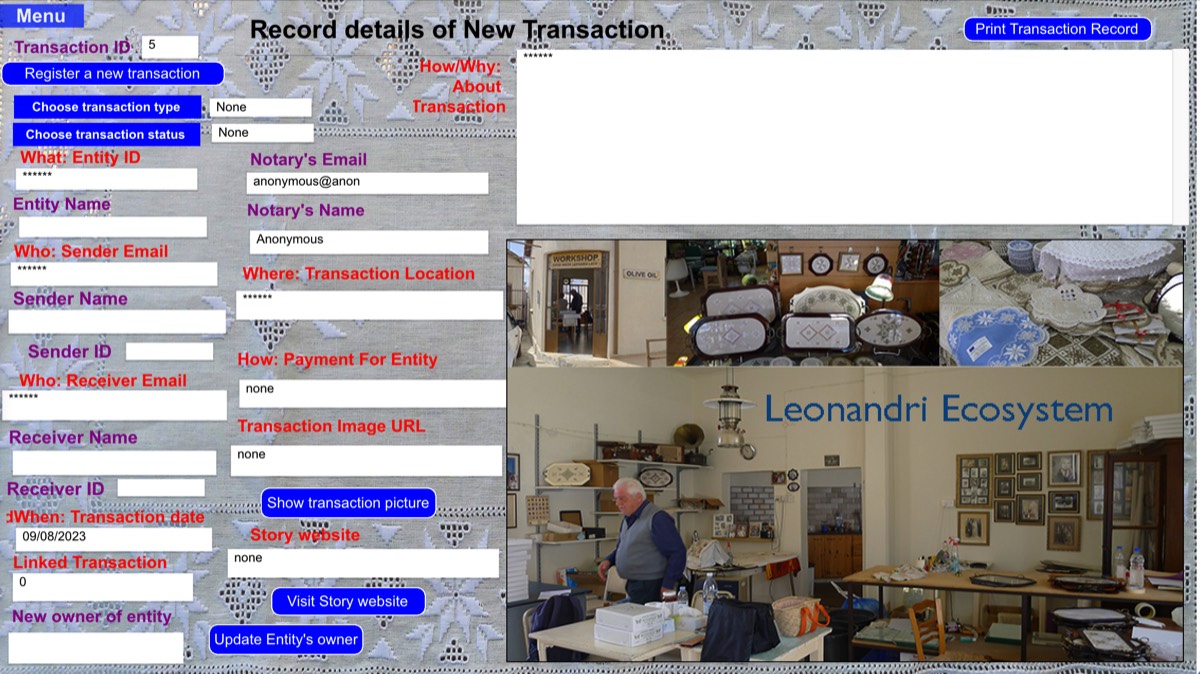Provenance Creative App Screen:
Record Details of New Transaction

In order to create a record for a new Transaction the App user must be currently logged in. Then, when this screen is accessed by the user, he or she finds that he or she is already identified as the Notary Agent for this transaction, and must take personal responsibility for the verification and validation of the information about the transaction that he or she provides here.
When the Notary Agent indicates that he or she is ready to start recording the details of this new Transaction he or she is invited to “Chose transaction type” from a pop-up menu (choice of Buy-sell, Gift, Barter, Lease, Public Deposit or Public Access request) and also to “Choose transaction status from a pop-up menu (choice of Open, Completed or Aborted). The Notary Agent is then invited by the App to fill in all the fields marked in red.
The field “New Transaction ID” is marked in purple on this screen, which indicates that this field is automatically filled in by the App rather than by the Notary user. Transaction identification numbers are uniquely assigned by the App in a continuous sequence, so there is no possibility of a duplicate transaction number being assigned to a new transaction.
Then, regarding the “Who” of the transaction, the fields “Entity name”, “Sender name” and “Receiver Name” are automatically entered by the App, consistent with the information given in red. The identified Sender and Receiver of the transacted Entity may or may not be members of the Leonandri Ecosystem.
If the Provenance Builder App finds that the sender or receiver is not registered in its MariaDB database, the Notary is given the option to get the unregistered sender or receiver (or both) to register as a member of the Ecosystem. Alternatively, the transaction may be registered with the sender or receiver (or both) marked as “unregistered’ (and thus without an Agent ID in the Leonandri Ecosystem. In this case, there is no Agent profile information available about the unregistered Agent.
The App then shows to the Notary Agent. the “confirm transaction” button. The Notary should first fill in all the fields marked in red, thus providing information about the transaction in terms of “When” (transaction date), “Where” (location of the transaction) “How” (information about transaction process and reciprocity, including payment method and amount (if any) and any linked transactions that are also identified in this transaction record by its ID. (A “Barter” is usually effected through linked transactions marking the reciprocal flow of the goods involved).
All these fields have scrolling capabilities, so considerable details may be inserted where relevant. Finally, the “About Transaction” scrolling field (which has a 3000 characters content limit) provides a facility for recording interpretive data about “How” and “Why” regarding the transaction process and context. When the user clicks on the “Confirm Information” button, the App performs various verification checks on the information presented in the fields and notifies the user of any errors, and provide to opportunity to correct them. When these corrections have been made, the App identifies the new owner of the transacted entity (who may be the Sender, the Receiver or “public domain”, depending on the transaction type)
The provenance Creator App then confirms that the Transaction Profile is verified and that the relevant details have been entered in the App’s MariaDB database.
